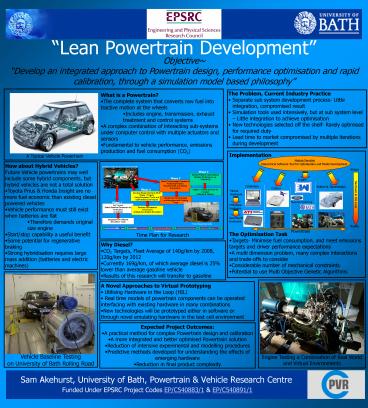Lean Powertrain Development PowerPoint PPT Presentation
1 / 1
Title: Lean Powertrain Development
1
Lean Powertrain Development
ObjectiveDevelop an integrated approach to
Powertrain design, performance optimisation and
rapid calibration, through a simulation model
based philosophy
- The Problem, Current Industry Practice
- Separate sub system development process- Little
integration, compromised result - Simulation tools used intensively, but at sub
system level Little integration to achieve
optimisation - New technologies selected off the shelf- Rarely
optimised for required duty - Lead time to market compromised by multiple
iterations during development
Implementation
- How about Hybrid Vehicles?
- Future Vehicle powertrains may well include some
hybrid components, but hybrid vehicles are not a
total solution - Toyota Prius Honda Insight are no more fuel
economic than existing diesel powered vehicles - Vehicle performance must still exist when
batteries are flat - Therefore demands original size engine
- Start/stop capability a useful benefit
- Some potential for regenerative braking
- Strong hybridisation requires large mass addition
(batteries and electric machines)
Virtual Hardware
Prototype Hardware
Real World Hardware
- The Optimisation Task
- Targets- Minimise fuel consumption, and meet
emissions targets and driver performance
expectations - A multi dimension problem, many complex
interactions and trade-offs to consider - Considerable number of mechanical constraints
- Potential to use Multi Objective Genetic
Algorithms
- Why Diesel?
- CO2 Targets, Fleet Average of 140g/km by 2008,
120g/km by 2012 - Currently 169g/km, of which average diesel is 25
lower than average gasoline vehicle - Results of this research will transfer to gasoline
- A Novel Approaches to Virtual Prototyping
- Utilising Hardware in the Loop (HIL)
- Real time models of powertrain components can be
operated interfacing with existing hardware in
many combinations - New technologies will be prototyped either in
software or through novel emulating hardware in
the test cell environment
- Expected Project Outcomes
- A practical method for complex Powertrain design
and calibration - A more integrated and better optimised Powertrain
solution - Reduction of intensive experimental and modelling
procedures - Predictive methods developed for understanding
the effects of emerging hardware - Reduction in final product complexity
- Sam Akehurst, University of Bath, Powertrain
Vehicle Research Centre - Funded Under EPSRC Project Codes EP/C540883/1
EP/C540891/1

